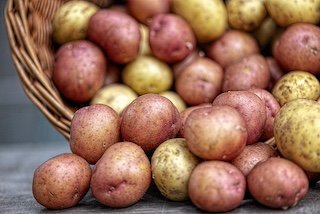

In the realm of root vegetables, potatoes and sweet potatoes command significant fanfare. The longstanding debate about which spud reigns supreme from a nutritional standpoint can often leave health enthusiasts perplexed. This blog post aims to dissect the nutritional intricacies of Sweet Potatoes vs Potatoes to better equip you to make healthy dietary choices. 🍠🥔
Nutritional Values of Sweet Potatoes vs Potatoes
It’s essential to recognise that both potatoes and sweet potatoes are loaded with an array of nutrients. A medium-sized sweet potato is rich in vitamin A, Rich in Beta-Carotene, vitamin C, manganese, and fibre, whilst containing smaller amounts of vitamin B6 and potassium.
Regular potatoes, conversely, are abundant in vitamin B6, vitamin C, and potassium, and contain respectable levels of manganese and fibre.
It’s interesting to note that the exact nutritional profile can fluctuate based on the specific variety of the potato or sweet potato you choose.
Suggested: No Sugar Diet Guide and 7 Days Diet List
Foods for Heart Health
Nutritional Content:
- Sweet Potatoes:
- Rich in Beta-Carotene: High levels of beta-carotene, which the body converts into vitamin A.
- Vitamins and Minerals: Good source of vitamins C and B6, potassium, and manganese.
- Potatoes:
- Rich in Vitamin C: Particularly in the skin.
- Potassium: Contains potassium and vitamin B6.
Here are the approximate nutritional values for a medium-sized sweet potato and a medium-sized white potato:
Sweet Potato (about 5 inches long, 130 grams):
- Calories: 112
- Protein: 2 grams
- Fat: 0.1 grams
- Carbohydrates: 26 grams
- Dietary Fiber: 3.9 grams
- Sugars: 6 grams
- Vitamins and Minerals:
- Vitamin A: 438% of the Daily Value (DV)
- Vitamin C: 34% DV
- Potassium: 15% DV
- Vitamin B6: 10% DV
White Potato (about 5 inches in diameter, 213 grams):
- Calories: 163
- Protein: 4.3 grams
- Fat: 0.2 grams
- Carbohydrates: 36 grams
- Dietary Fiber: 3 grams
- Sugars: 1.9 grams
- Vitamins and Minerals:
- Vitamin C: 29% of the Daily Value (DV)
- Potassium: 26% DV
- Vitamin B6: 21% DV
These values can vary based on the specific variety and cooking method. It’s important to note that both sweet potatoes and white potatoes offer different nutritional benefits, and including a variety of vegetables in your diet is recommended for optimal health.
Suggested: Plant Protein vs Animal Protein
Herbal Teas for Weight Loss
Analysing Calorie Content
Fuel is fundamental for the functioning of our bodies and calories provide this essential energy. A medium-sized potato and a medium-sized sweet potato have relatively close calorie counts. With around 163 calories found in a regular potato, compared to the approximately 112 calories in a sweet potato.
Nonetheless, the calorie count can quickly climb if high-calorie toppings like butter or cream are included in your dish. It’s worth considering your accompaniments when contemplating the overall calorie content of your potato-based meals.
Inspecting the Fibre Factor
The role of dietary fibre in promoting a healthy digestive system is undisputed. This crucial nutrient aids in achieving regular bowel movements and fostering a healthy gut microbiome.
Interestingly, both our contenders, sweet potatoes vs potatoes, offer a commendable source of dietary fibre. Sweet potatoes, however, slightly outpace their counterparts, providing around 4 grams of fibre in a medium-sized serving as opposed to the 3 grams found in an equivalent portion of potatoes. Therefore, if you’re aiming to elevate your fibre intake, sweet potatoes might be a marginally superior choice.
Sweet Potatoes vs Potatoes: Insulin Resistance
Insulin resistance manifests when your body’s cells are unable to effectively utilise insulin, potentially paving the way for health complications like type 2 diabetes and heart disease.
Glycemic Index
- Sweet Potatoes:
- Lower Glycemic Index: Generally considered to have a lower impact on blood sugar levels.
- Potatoes:
- Higher Glycemic Index: Can cause a quicker spike in blood sugar.
The carbohydrate content in both potatoes and sweet potatoes is comparable. However, the Glycaemic Index (GI) of sweet potatoes is notably lower than that of regular potatoes, signifying that their consumption is less likely to result in a rapid surge in blood sugar levels. Consequently, sweet potatoes could be a more suitable option for individuals who have insulin resistance or are vulnerable to developing this condition.
Suggested: Cell Regenerating and Rejuvenating Foods for a Healthy You
Which Food Keeps You Full?
When considering which of these spuds will leave you feeling more satisfied post-meal, the level of protein and fibre comes into play. Regular potatoes hold a slightly higher protein content, which is well-regarded for its satiating effect. On the flip side, sweet potatoes possess a marginally higher fibre content, another element linked to prolonged feelings of fullness.
Though both varieties have their strengths in this regard, the lower GI of sweet potatoes may offer an additional advantage in maintaining a sustained sense of satiety. However, it is important to note that a balanced diet will invariably include both proteins and fibres, so including both types of potatoes in your diet can contribute to an overall feeling of fullness.
Impact on Blood Sugar Levels
Balancing blood sugar levels is a key concern for those living with diabetes or prediabetes. Foods with a lower Glycaemic Index (GI) are typically chosen for their ability to elicit a more gradual increase in blood glucose levels. Given their lower GI, sweet potatoes stand out as a beneficial choice in this context.
Nevertheless, it’s vital to remember that the way you cook these root vegetables can profoundly alter their GI. Hence, mindful selection of preparation methods is just as crucial as choosing the right type of potato.
Both sweet potatoes and potatoes can be part of a healthy diet when prepared in a balanced and varied way. The choice between them often comes down to personal preference and the specific nutritional benefits you’re seeking. 🍠🥔
